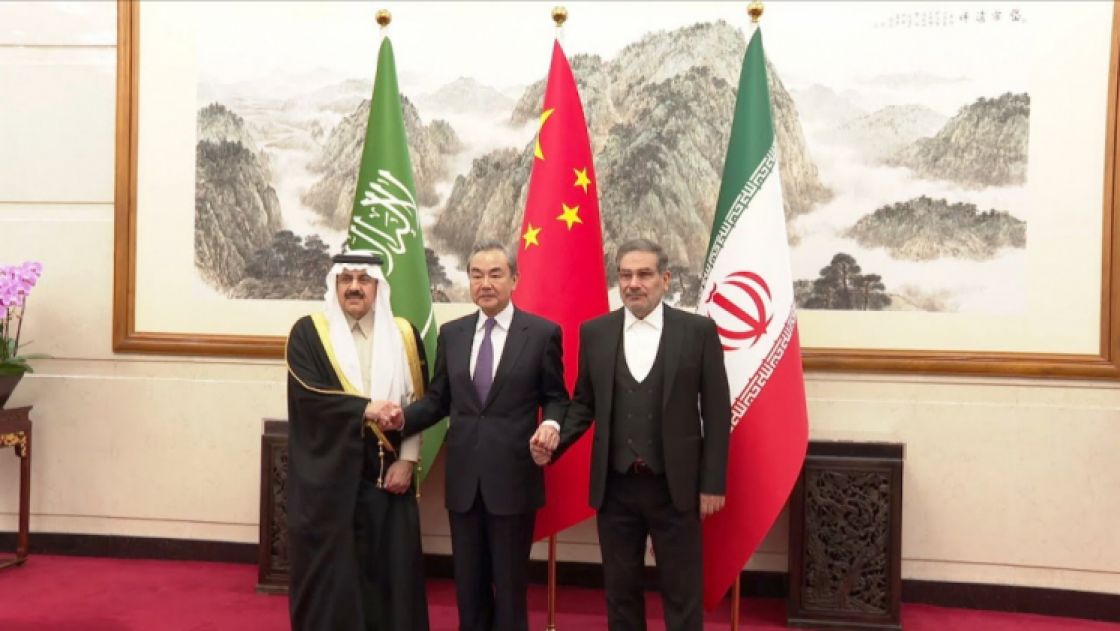- Articles
- Posted
China Closes the “Creative Chaos” Door and Open the Stability Door
(The following article was originally published in English on geopolitika.ru on the 17th of March 2023)
On Friday, March 10, a historic agreement was announced between Saudi Arabia and Iran, including resumption of diplomatic relations between the two neighboring countries after an interruption that lasted more than seven years (since January 2016). This agreement was reached through Chinese mediation at the highest levels. The two sides expressed gratitude to Chinese President Xi Jingping personally for his efforts to achieve a settlement between the two countries.
Anyone supporting global peace, anywhere in the world, will certainly appreciate that two important regional powers – Saudi Arabia and Iran – have reached a settlement of their conflict in such a sensitive and influential region as the Middle East. Due to their economic, political, and spiritual influence, these two countries have a crucial effect on many hot issues in the region, such as Lebanon, Syria, Yemen, Iraq, and others.
Anyone who wants world peace will welcome this agreement, as it comes after a long continuous conflict, which had not started in 2016, but actually in 1979. This conflict has gone through many stages of extreme tensions, particularly during the last two decades. Nevertheless, there are other angles that incentivize warmly welcoming this agreement with a great amount of hope for the entirety of the Middle East.
Saudi Arabia is nearly the biggest Arab country in the economic and political sense. It is also an important spiritual center for hundreds of millions of Muslims around the world, as the country that has Mecca, the holiest religious place for Muslims. Additionally, Saudi Arabia, in certain political-cultural categories, is considered the Sunni center of the world, and Sunni Muslims are a main sect in Islam, next to Shia Muslims and other sects.
Iran is also a very important country in the region, whether in terms of its economic, political, or spiritual influence. It is also the heir of an ancient historical empire, the Persian Empire. Iran is also considered one of the main centers of Islam and is classified as the center of Shia Islam.
In 2003, with the US invasion of Iraq, a country that borders both Saudi Arabia and Iran, Washington started to openly evoke the ghosts of ancient history to exploit them in the battles of the present. In this regard, the U.S. evoked historic battles dating back hundreds of years between the Persian and Arab Empires, as well as intra-Islam sectarian conflicts between Sunnis and Shias dating back nearly 1400 years.
These two elements – the Arab-Persian ethnic conflict and the Sunni-Shia sectarian conflict – were the main elements within the set of consecutive American projects relating to the Middle East. These projects include: “The Greater Middle East” in 2004, during George W. Bush’s presidency; then “The New Middle East” in 2006, which was formally and jointly declared by Washington and Tel Aviv. However, the first person to use the expression “creative chaos” in 2005, during an interview with the Washington Post, was then U.S. Secretary of State, Condoleezza Rice. In that interview, Rice talked about creating a new Middle East through what she called “creative chaos.”
Later, and through practical experience, it became clear that this chaos had various tools and forms. The most important of these tools was exploiting religious, sectarian, and nationalistic issues, as well as direct and indirect military interventions, and last, but not least, practically supporting terrorism. One of the pillars of this creative chaos was fueling the Sunni-Shia conflict and then the Arab-Persian one. Based on this, hatred spread throughout the entire region, on absolutely irrational basis, reaching the point of direct incitement to brutally murder based on religious or sectarian differences. That is, the behavior of terrorist organizations such as ISIS is a natural evolution of the hatred seeds sown by “creative chaos.”
Returning to Saudi Arabi and Iran, as the spiritual representatives of Sunnis and Shias, having a continuous conflict and tension between them was a main prerequisite for creative chaos to persist. Therefore, settling disputes between the two countries is of the utmost importance for all the peoples of the Middle East.
Additionally, Washington has attempted over the last two decades, especially the last ten years, to draw an imaginary line, based on which it pushed peoples and countries of the Middle East into fierce wars. On one side of the line, the U.S. wanted to bring its ally Israel together with Arab countries, and without a just solution to the Palestinian cause, and tricks under such names as “the Abraham Accords” and the “Arab NATO”. On the other side, it put Iran, on the basis of the supposed hostility between Arabs and Persians, and between Sunnis and Shias, where this hostility allegedly has no solution except warring till death.
Washington implicitly benefited from continuous extortion of the Arab Gulf countries, by alleging that it protects them from Iran. It also benefited from the massive arms deals, worth hundreds of billions of dollars, that it sold to the Gulf countries.
This Chinese-mediated agreement, means closing the door on a major tool of the U.S.’s destructive chaos tools in the Middle East, and it also means pushing the door wide open towards peace and stability, on the basis of mutual respect for interests and cultures.
Source: CHINA CLOSES THE “CREATIVE CHAOS” DOOR IN THE MIDDLE EAST, AND OPEN THE STABILITY DOOR



